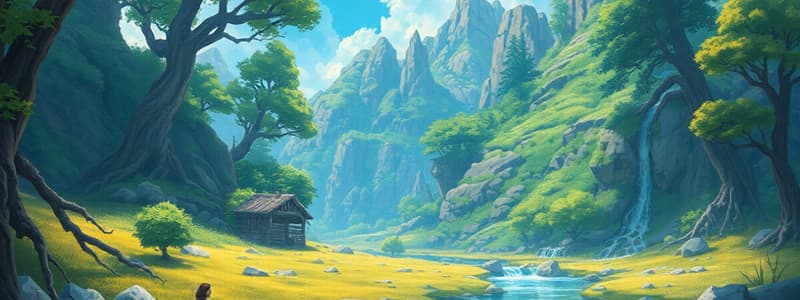Podcast
Questions and Answers
What characteristic distinguishes a biome?
What characteristic distinguishes a biome?
- The geographic location of the area
- The seasonal weather patterns
- The types of plants and animals living in it (correct)
- The elevation above sea level
Which biome is characterized by a cold climate and is the largest of all biomes?
Which biome is characterized by a cold climate and is the largest of all biomes?
- Savanna
- Tundra
- Taiga (correct)
- Temperate deciduous forest
What role do keystone species play in their ecosystems?
What role do keystone species play in their ecosystems?
- They are the first to colonize barren environments
- They are only found in areas with high biodiversity
- They are the most abundant species in the ecosystem
- They have a significant impact on the habitat and other species (correct)
What is the main difference between primary and secondary succession?
What is the main difference between primary and secondary succession?
What can be inferred about indicator species?
What can be inferred about indicator species?
How is biodiversity index calculated?
How is biodiversity index calculated?
Which of the following best describes the chaparral biome?
Which of the following best describes the chaparral biome?
What is the significance of mangrove trees in coastal ecosystems?
What is the significance of mangrove trees in coastal ecosystems?
Flashcards
Biome
Biome
A large-scale community of plants and animals that share a common climate and environmental conditions.
Keystone Species
Keystone Species
Species that have a significant impact on their habitat and influence the distribution of other species.
Indicator Species
Indicator Species
Species that are highly sensitive to changes in their environment and can serve as indicators of environmental health.
Pioneer species
Pioneer species
Signup and view all the flashcards
Primary succession
Primary succession
Signup and view all the flashcards
Secondary succession
Secondary succession
Signup and view all the flashcards
Biodiversity Index
Biodiversity Index
Signup and view all the flashcards
Invasive species
Invasive species
Signup and view all the flashcards
Study Notes
Biomes
- Biome: An area of the planet characterized by specific plants and animals, defined by temperature, soil, light, and water.
- Characteristics of biomes include: temperature, soil type, amount of sunlight, and water availability.
- Different types of biomes: Alpine, chaparral, desert, grassland, savanna, taiga, temperate deciduous forest, tropical rainforest, and tundra.
Types of Biomes
- Alpine: Mountainous regions, cold temperatures, and limited plant growth.
- Chaparral: Hot, dry summers and mild winters; prone to fires; low-lying vegetation.
- Desert: Can be hot or cold; has very little vegetation due to low rainfall.
- Grassland: Large areas of grasses with few trees; susceptible to fires.
- Savanna: Grassland with scattered trees; warm and rainy seasons, but drought periods.
- Taiga: Largest biome; long, cold winters; coniferous trees.
- Temperate Deciduous Forest: Four distinct seasons; many deciduous trees.
- Tropical Rainforest: Warm, rainy weather year-round; high biodiversity.
- Tundra: Extremely cold; treeless; permanently frozen ground (permafrost).
Climate vs. Weather
- Climate: Long-term average weather conditions.
- Weather: Daily average weather conditions.
Keystone Species
- Keystone species: Species that have a large impact on their habitats and many other species.
Indicator Species
- Indicator species: Species that are very sensitive to environmental changes, and provide insight into the health of the habitat.
Mangrove Trees
- Mangrove trees: Their leaves filter excess salt from brackish water; roots stabilize coastlines and reduce erosion; provide habitat for fish.
Succession
- Primary succession: Occurs on surfaces where no soil exists (e.g., volcanic rock); pioneer species like lichens break down rock to form soil.
- Secondary succession: Occurs on surfaces where soil already exists (e.g., after a flood or fire); existing soil supports faster growth.
Pioneer Species
- Pioneer species: The first species to inhabit an environment lacking vegetation. (e.g., lichens)
Biodiversity Index
- Biodiversity index: Measures the number of species in an area and the number of individuals of each species (a higher index indicates higher diversity).
Invasive Species
- Invasive species: Species that spread rapidly and outcompete native species for resources.
Line Transect
- Line transect: A sampling method used to count the number of species along a measured line.
Climatograms
- Climatograms: Show temperature and rainfall over time, used to identify biomes. They can help measure human activity impact.
Studying That Suits You
Use AI to generate personalized quizzes and flashcards to suit your learning preferences.




